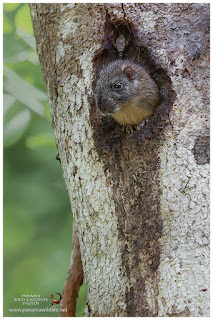Pipeline Road is a magical place, and not just for birds as this post shows. In January we went there with just one target on mind, a Pheasant Cuckoo that was reported for several days. Unfortunately the cuckoo moved and was not any close. Then, we walked on the trails and visited the look-out at the lake. During the short visit we observed and photographed some inhabitants of the area but the jackpot at the end of the round was a spiny rat, a species which population status is largely unknown, but it is probably not uncommon in it's range or even locally common in Panama's protected areas and on Barro Colorado Island.

The
Rufous Soft-furred Spiny-rat or
Rufous Tree Rat (Diplomys labilis) is a species of
rodent in the family
Echimyidae. It's found in evergreen and deciduous forest, mangroves, plantations, and second growth in Panama, Colombia, and Ecuador, but in November 2015, it was spotted for the first time in Osa, Costa Rica. Rats of this family have hard hair like thorns, not so much like a porcupine, but harder than normal and, therefore, it is known as spiny rat or "ratón espinoso" in Spanish.

It is nocturnal and arboreal species, feeding probably on fruit and young tender leaves and shoots. In fact, it never has been caught or seen at ground level. He moves among the branches of tall trees, usually at night, when they are most active. During the day, adult pairs or lone individuals sleep in holes in trees, they stick their heads out, and can rest for long periods, almost without moving.
The threats to this species are unknown but unfortunately they had lost much of his habitat in it's geographic range due to deforestation.
Now, these are some of the other species we were able to photograph that day:
Rufous-crested Coquete (Lophornis delattrei) - male
Rusty-margined Flycatcher (Myiozetetes cayanensis)
Smooth-billed Ani (Crotophaga ani)
Spotted Antbird (Hylophylax naevioides) - female
Violet-bellied Hummingbird (Juliamyia julie)
Yellow-tailed Oriole (Icterus mesomelas)













Comments
Post a Comment